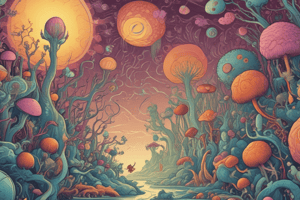Podcast
Questions and Answers
What is biology?
What is biology?
The study of all living things.
The smallest living unit of an organism is a ______.
The smallest living unit of an organism is a ______.
cell
Which of the following are considered organisms? (Select all that apply)
Which of the following are considered organisms? (Select all that apply)
- Protists (correct)
- Fungi (correct)
- Bacteria (correct)
- Rocks
All cells contain a nucleus.
All cells contain a nucleus.
What type of reproduction involves two parents?
What type of reproduction involves two parents?
The union of an egg cell and sperm cell results in a ______.
The union of an egg cell and sperm cell results in a ______.
What is the haploid condition?
What is the haploid condition?
Which of the following are producers?
Which of the following are producers?
Fungi can undergo photosynthesis.
Fungi can undergo photosynthesis.
Which cell type lacks a nucleus?
Which cell type lacks a nucleus?
An organism that has both male and female sex organs is called a ______.
An organism that has both male and female sex organs is called a ______.
What is the purpose of cellular respiration?
What is the purpose of cellular respiration?
Flashcards are hidden until you start studying
Study Notes
Overview of Biology
- Biology studies all living things or organisms.
- Organisms include bacteria, protists, fungi, plants, and animals.
Cells
- Cells are the smallest living unit of any organism.
- Every cell has a living material known as cytoplasm, which contains organelles and is enclosed by a cell membrane that regulates entry and exit.
Types of Cells
- Prokaryotic: Cells that lack a nucleus and membrane-bound organelles, typically simpler in structure.
- Eukaryotic: Cells containing a nucleus and membrane-bound organelles, more complex and organized.
Domains of Life
- Eukarya: Organisms with eukaryotic cells.
- Prokarya: Groups of prokaryotic organisms.
- Archaebacteria: A type of prokaryotic organism.
Organism Classification
- Unicellular: Organisms made of one cell.
- Multicellular: Organisms composed of many specialized cells.
Five Kingdoms of Life
- Monera: Prokaryotic cells/bacteria (unicellular).
- Protista: Eukaryotic cells (unicellular).
- Fungi: Eukaryotic cells (unicellular if yeast, multicellular otherwise).
- Plantae: Eukaryotic cells (multicellular).
- Animalia: Eukaryotic cells (multicellular).
Common Characteristics of Living Things
- Comprised of cells, reproducing, based on a universal genetic code (DNA).
- Grow and develop.
- Obtain and utilize materials and energy.
- Respond to environmental changes.
- Maintain homeostasis, evolving as a group over time.
Reproduction
- Sexual Reproduction: Involves two parents, gametes unite during fertilization, leading to a zygote.
- Asexual Reproduction: Involves one parent, offspring are clones of the parent.
Growth and Development
- Organisms grow through cell production and enlargement.
- Development transitions from zygote to embryo, then fetus.
Chromosomes
- Haploid Cells: Contain a single set of chromosomes.
- Diploid Cells: Contain two sets of chromosomes.
- Zygotes are diploid with 23 pairs, totaling 46 chromosomes, designated as XX (female) or XY (male).
Organism Types
- Producers: Create their own food from sunlight or chemicals.
- Consumers: Obtain energy by eating other organisms.
- Decomposers: Break down dead organic material.
Cellular Respiration
- Process by which cells release chemical energy from food.
- The equation: C6H12O6 + 6O2 → 6CO2 + 6H2O + energy.
Nutrition Types
- Autotrophs: Synthesize their own food.
- Photoautotrophs: Use sunlight (photosynthesis).
- Chemoautotrophs: Utilize chemicals for energy.
- Heterotrophs: Cannot create their own food; rely on other organisms for energy.
Photosynthesis
- Converts light energy into chemical energy.
- The equation: 6CO2 + 6H2O + light → C6H12O6 + 6O2.
Studying That Suits You
Use AI to generate personalized quizzes and flashcards to suit your learning preferences.




